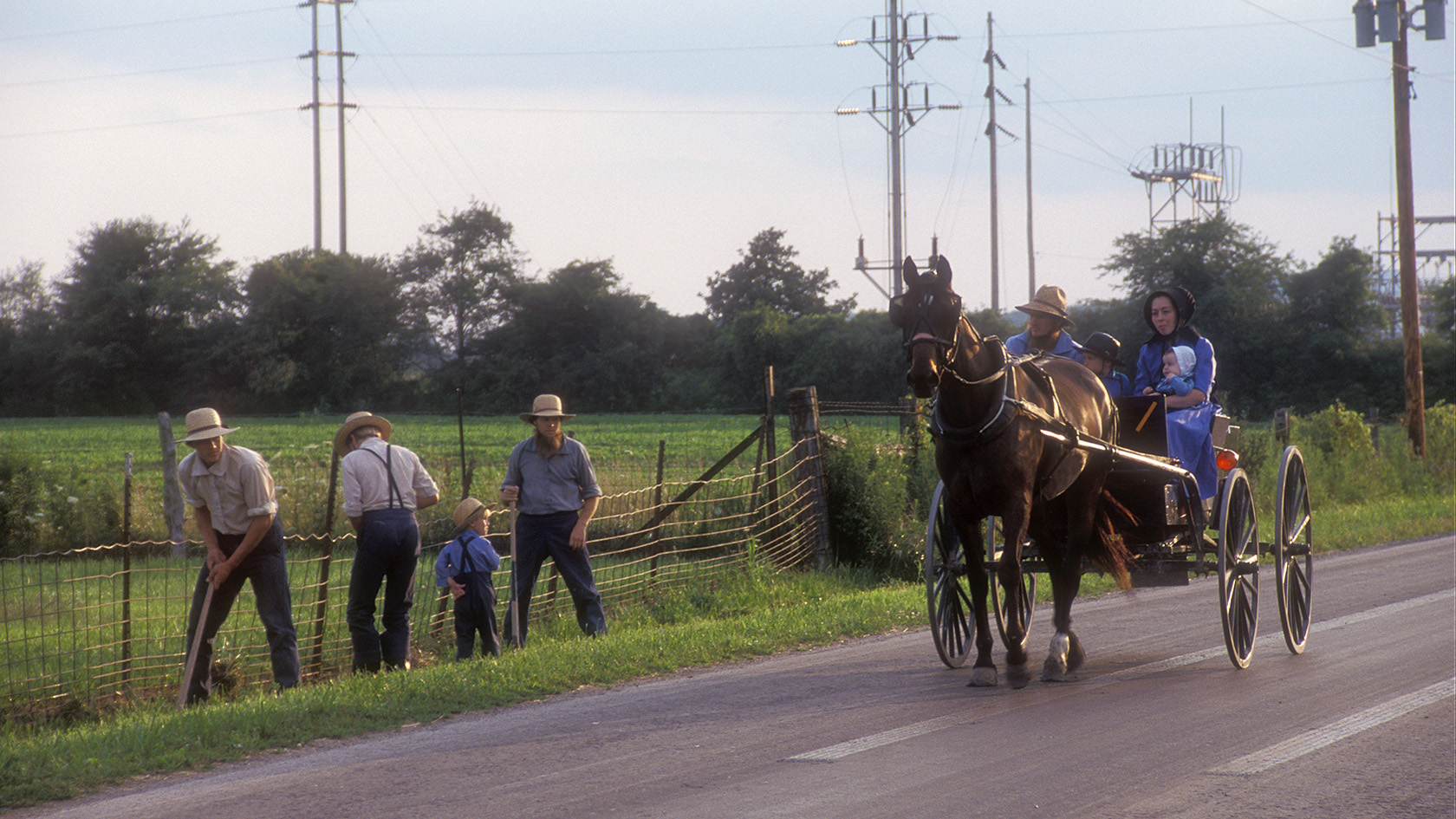Driven to Work by the “Fahri”

When UZH researcher Anja Hasse first arrived in Berne, Indiana, a modest mid-western town three hours by car from Chicago complete with a replica of its Swiss counterpart’s Zytglogge tower, she was pretty astonished. One surprise was the ubiquitous sight of large families decked out in old-fashioned clothing driving to Pizza Hut in horse-drawn carts, looking for all the world as if they’d just stepped off a movie set. For the linguist, though, the really fascinating thing was overhearing their conversations. The families were using a language that sounded amazingly like the dialect spoken by her compatriots in Bern, Switzerland.
The Swiss Amish in Adams County are one of the most conservative groups in the Amish community (see box). They reject all technology and live without electricity or running water – but that doesn’t mean they’re completely cut off from the modern world. “Even Amish people know how to order a cappuccino by touchscreen.” Their farms may be scattered around the countryside some distance from Berne, but many Amish men work in the town as tradesmen and just like average American families, they regularly shop at Walmart – there are only a few self-sufficient families left in the area. And even the Amish sometimes need a little more horsepower than their usual wagons: “Then they ask a ‘Fahri’ to drive them,” explains Hasse, a researcher in the Department of German and Scandinavian Studies at UZH. “Fahri” is the Amish word for the non-Amish drivers who drive them to work or to the store in their cars (from the German “Fahrer”, driver).
Rejection of the oath and military service
The language is another thing that separates the Amish around Berne from the English-speaking majority – and it also marks them out from other Amish groups, most of whom speak a German dialect somewhat misleadingly called Pennsylvania Dutch. The Swiss Amish speak to each other in Shwitzer, a language related to the Bernese German of their ancestors. Since 2020, as part of a project funded by the Swiss National Science Foundation, Hasse and other researchers have been investigating how Shwitzer managed to survive and evolve over so many centuries.
The roots of all Amish – not just the Adams County community – go back to the 16th-century Emmental Anabaptists. For these Christians, the reforms of Zwingli and Luther didn’t go far enough: they believed church membership should be a voluntary conscious decision, with adult baptism a central element of the movement. The Anabaptists spurned official church services, refused to swear the oath of allegiance, and rejected military service. They further accused church and state of entering into an unholy alliance, reports the Historical Lexicon of Switzerland.

Amish people know how to order a cappuccino by touchscreen.
Their rebellion quickly aroused the ire of the powers that be: Anabaptist believers in Bern and Zurich were thrown in jail, tortured, exiled or executed. From 1650, the Emmental Anabaptists fled the cities, mainly for the Bernese Jura and the Franche-Comté region. By the end of the 17th century, the Anabaptists had split into two branches: the Amish, who wanted to strictly cut themselves off from mainstream society, and the group around the Berne preacher Jakob Amman – hence their name, the Mennonites – whose attitude was less strict. During the 18th and 19th centuries, members of both groups emigrated to the USA, where the Mennonites founded the new city of Berne in 1852.
Mennonites and Amish still live alongside each other in Adams County to this day, but barely come into contact in their daily lives. While the Amish are still clearly distinguishable from mainstream society, the modern Mennonites’ lifestyles and appearance are not much different than the average US citizen. The gap between the two groups is also evident in their language: during their European exile, both communities initially retained the Bernese German dialect of their ancestors, as neither group had much contact with the French-speaking Catholic population. But after their arrival in the USA, the dialects began to diverge and now exist as two distinct independent linguistic enclaves.
Life in a bubble
During her research field trips to Adams County, Hasse mainly talked to members of the Amish community. Hasse is an assistant to linguistics professor Guido Seiler, who led the research project.
The Amish Shwitzer is remarkable for several reasons, says Hasse. Firstly, linguistic enclaves formed by emigrants usually die out after two or three generations, but with Shwitzer, many more people speak it today than did 100 or 200 years ago. The exact figures are not known, because the Amish don’t take part in censuses, but Hasse estimates that they are in the region of several thousand. “The Amish population doubles every 20 to 25 years.” Nevertheless, the high birth rate, the isolation and the fact that almost nobody leaves the community are not on their own enough to explain how the language has survived for so long. “Shwitzer is also an important aspect of the Amish identity and a way of differentiating themselves,” says Hasse.
The lifestyle of the Amish, cut off from mainstream society, seems to have provided ideal conditions for the language to be retained and at the same time evolve. Yes, evolve – Shwitzer is by no means an archaic language with unwieldy vocabulary that no-one understands any more, but rather is lively and innovative, found the UZH research team. “The language is still highly functional,” says Hasse. “There was never any danger that the community would switch to another mother tongue.” With the Mennonites’ Berndeutsch it is a different story. While it still sounds pretty much the same as the language spoken by the Swiss founding fathers of Berne, Indiana, hardly anyone speaks it any more – the more progressive community long ago adopted English as their first language.
“On our last visit to Berne, we met precisely one Berndeutsch speaker,” says Hasse. She and the handful of other Mennonites in the area who are still able to converse in Bernese are well over 80 years old. The Amish, in contrast, continue to teach their children Shwitzer as their first language. They don’t learn English until they go to school.
Influential Pennsylvania Dutch
Hasse was surprised at the way in which Shwitzer had developed away from its origins. In most cases of linguistic contact, words are borrowed from another language and then gradually adapted to fit the pronunciation, orthography and inflection of the original language. Examples in High German are “Streik” from the English “strike” or “Mauer” (wall) from the Latin “murus”. “Shwitzer has largely kept its Bernese German vocabulary and pronunciation,” says Hasse. “But the sentence structure and grammar are strongly influenced by external factors.” For example, Shwitzer has developed a form of future tense.
The biggest influence comes not, as one might think, from American English, but from Pennsylvania Dutch. It is thought that the Pennsylvania dialect, which stems from Palatine German, found its way into the Swiss Amish community when women from other Amish groups married in. Hasse has a theory about why the language may have developed in this unusual way: the wives wanted to integrate quickly into their new community and made efforts to learn the new language, surmises the linguist. “But vocabulary and pronunciation are easier to learn and reproduce than grammatical structures.” Thus certain rules and constructs of Pennsylvania Dutch were unconsciously retained and passed on to the next generation.
On her first trip to Berne, Hasse was surprised with how quickly the sight of women in long skirts and bonnets or hitching posts for horses in front of fast-food restaurants and supermarkets became normal to her. But the linguistic questions arising from this unusual lifestyle remain a source of fascination for the dedicated researcher.